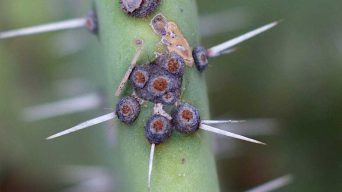Spider mites are tiny spider-like creatures that can wreak havoc on cactus plants.
These bugs are well known for sucking the life out of even the hardiest of cacti, and when left unchecked, spider mites will cause your beloved plants to produce withered leaves and die off.
Fortunately, spider mite infestations do not need to be a death sentence for your garden.
This guide will show you how to get rid of spider mites on your cactus plant and keep spider mites off in the future.
What Are Spider Mites?
Spider mites are spider-like pests, sometimes known as the spider-mite, spider red mite, or common red spider mite, which are tiny arachnids that feed on plant tissue.
They have eight legs as adults and six or more as juveniles, which is how they get their name.
The spider part of the name comes from an old belief that these insect pests were a type of spider.
Spider mites are very common in greenhouses and indoor plants, but you can also find them outdoors.
There are many different types of spider mites with varying feeding preferences, so it’s essential to identify what kind your cactus has before treating these pests.
Some species prefer certain types of trees, whereas others may only eat succulents like agave and yucca, while still, other spider mites will only eat grasses.
The most common spider mite that feeds on cacti is called the two-spotted spider mite.
Where Do Spider Mites Come From?
There are several reasons why spider mites feed on these plants, but it has to do with where they dwell and what their food source is in that area.
Some spider mites may just be passing through your yard or garden when they find one of your cactus plants, which will then become a quick meal for them before continuing with their journey.
Most spider mite infestations begin when spider mite eggs hatch after being laid by an adult spider mite female during the nymphal stage.
Adult females can lay up to forty eggs per day, so it is important to get rid of spider mites on cactus plants before populations explode out of control.
The problem with spider mites beginning their lives in this manner is that you can’t tell if your plant has been infected until the first generation hatches from its egg.
What Do Spider Mites on Cactus Plants Look Like?
Spider mites are tiny pests that will destroy your plant if left untreated.
Adult spider mites have red or black bodies with two spots on their backs, which is where they get the name “two-spotted spider mite.”
They feed by piercing a hole in cactus leaves and sucking out the contents inside; this causes yellow patches to form and webbing between leaves and branches as spider mites attempt to protect themselves from predators like ants.
Cacti with spider mites will see their health decline and leaves wilt.
What Damages Do Spider Mites Cause on Cactus Plants?
Spider mites cause damage to cacti in several ways.
First, spider mites feed on healthy plant cells by piercing the surface of leaves and sucking out their contents like sap; this weakens your plant because its cell walls are damaged during the feeding process.
This leads to yellowing or brown patches forming on your cactus’ foliage as spider mite infestations progress which can be fatal if left untreated for too long.
Secondly, spider mites produce webbing around the plants they inhabit as a protective covering from ants that may attack them while looking for food sources.
Third, spider mites secrete a substance called honeydew onto surfaces near them which causes sooty mold growth if not cleaned up quickly.
Lastly, spider mites will sometimes feed on the stamen of flowers and cause them to drop prematurely, so it is important to get rid of spider mites if you see this happening in your cactus plants.
How To Treat Spider Mites on Cactus Plants
Spider mites on cactus plants can be a horrible experience for any plant lover.
Even though spider mite infestation is not as bad as it seems, spider mites always need to be treated before they take over and destroy the whole plant.
Spider mites are tiny pests that look like moving dots that feed by puncturing holes into the leaves of your plants and sucking out their sap/juices leaving behind yellow spots or stipples on them.
Once you spot spider mites infecting your cacti, you need to start treating them immediately. Here are a few spider mite treatment methods that you can use to get rid of spider mites on cactus plants:
Neem Oil
One of the best spider mite treatments is to use neem oil.
Neem oil has both insecticidal and pesticide properties that help get rid of spider mites on cactus plants by suffocating them, preventing their growth, or killing them in case if they have already penetrated deep into your plant tissues.
To use neem oil, mix the neem oil with water at a ratio of two teaspoons of neem oil per one quart (liter) of water.
Pour the mixture into an atomizer or spray bottle, then start spraying each cactus leaf, including their stems, until they are completely drenched in this spider mite treatment solution.
Insecticidal Soap
Another natural way that has been proven effective is using insecticidal soap against spider mites on cacti plants. Insecticidal soap kills spider mites, but it does not harm any other insects, spider mites, natural enemies, and pollinators.
To use this spider mite treatment method, mix one teaspoon of insecticidal soap with a gallon of water in a spray bottle, then spray it on spider mites infected leaves.
Horticultural Oil
Horticultural oil spider mite treatment is another natural spider mites killer that works against spider mites on cactus plants.
This spider mite treatment method provides a protective coating around leaves to suffocate spider mites by blocking their access to the plant’s surface.
To use this spider mite treatment, mix one tablespoon of horticultural oil with two gallons of water in a spray bottle, then shake well before using it for each application.
Once you are done mixing your mixture, spray all parts of your cacti where spider mites might be hiding, including their stems, crevices, and any other place spider mites are likely to be present.
Predatory Mites
Another effective way to get rid of spider mites on cacti plants is by introducing predatory mites that feast upon spider mite eggs, larvae, nymphs, and adults.
These predators will kill spider mites without harming other insects, spiders’ natural enemies, or pollinators.
You will need to keep releasing predatory mites every few days to increase spider mite mortality.
High-Pressure Water
High-pressure water is another spider mite treatment method that you can use to get rid of spider mites on cactus plants.
The high-pressure jet will dislodge spider mites by blasting them off the leaves into a bucket full of soapy or plain water, where they’ll drown and die eventually.
You may need to repeat this spider mite treatment for it to be fully effective, as some spider mites might have survived after getting blown away from your plant’s leaves.
Beneficial Insects
Another useful spider mite treatment method that you can use is to introduce beneficial insects such as ladybugs, green lacewings, and predatory wasps, which are spider mites’ natural enemies.
Ladybugs feed on spider mites eggs while the other two will feast upon spider mite larvae, nymphs, or adults, depending on their species.
You need to release these beneficial bugs every week until they rebuild your plant’s population of this predator/parasitoid in time for when spider mites come back next season.
Alcohol and Water
If spider mites on cactus plants have already penetrated deep into your plant’s tissues, the only spider mite treatment method that you can use is to pour alcohol or rubbing alcohol mixed with water at a ratio of one part rubbing/isopropyl alcohol and three parts water.
Pour this mixture directly onto each spider mite infected spot until they are all fully covered in it. Alcohol will dry out the spider mites’ exoskeleton resulting in their desiccation and eventual death while leaving your cactus leaves intact.
Dish Soap
Another spider mite treatment method you can use is to mix dish soap with water at a ratio of one teaspoon of dish soap per quart (liter) of water.
Then, pour the mixture into an atomizer or spray bottle and start spraying spider mites on cactus plants until they are completely drenched in it.
Dish soap will suffocate spider mites and kill them off by breaking up their exoskeleton’s integrity which eventually results in desiccation and death.
Diatomaceous Earth
If spider mites on cacti plants are still in their nymphal or larval stage, then another spider mite treatment method that you can use is to dust your plant’s leaves with diatomaceous earth.
This will dehydrate and kill them off while leaving other insects such as pollinators alone. You need to reapply this spider mite treatment every two weeks until all spider mites are gone.
Mouthwash
Another spider mite treatment method you can use is to mix mouthwash with water at a ratio of one teaspoon of soap per quart (liter) of water.
Pour the mixture into an atomizer or spray bottle and start spraying spider mites on cactus plants until they are completely drenched in it.
Mouthwash will suffocate spider mites and kill them off by breaking up their exoskeleton’s integrity which eventually results in desiccation and death.
How To Prevent Spider Mites on Cactus Plants
Firstly, to prevent spider mites on cactus plants, you need to choose a suitable location for the plant.
Avoid areas with low-level sunlight and hot weather. You should also avoid overwatering your cactus plants.
Ensure that spider mites are not present on your cactus before bringing it home from a nursery or garden center.
You can do this by shaking the plant near an open window and looking for spider mite webs, moving insects, webbing, larvae, eggs, or small spots on leaves.
Spider mites spread rapidly from plant to plant, so it is best to take measures before spider mites have a chance of infesting your cactus.
In the case that spider mites do manage to enter your house and settle on one or more of your plants, you should treat all susceptible plants to prevent spider mite infestations from spreading across multiple pots.
Final Thoughts
Like other common cactus pests like mealybugs and scale insects, spider mites can be a real pain for cactus growers.
Spider mites not only make spider webs on the plant, but they also suck sap from the plant through their rasping mouthparts and inject toxic saliva, which makes infested plants weak or even kills them in severe cases.
It is necessary to take spider mites seriously and act quickly in case of an infestation.
It can be overwhelming at first, but once you understand what spider mites are and how they damage plants, it will become easier to get rid of them.
Remember that spider mites are tiny and multiply fast, so act before the infestation becomes unmanageable.







